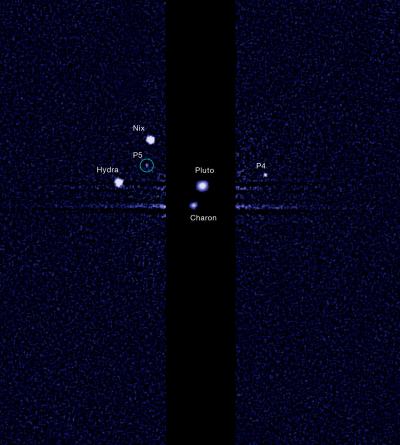Five moons, and STILL not considered a real planet. It's enough to make a person suspect that there is some Plutonian committee based on that distant rock trying to reclaim the status it held for the first couple of thousand years' worth of human astronomy, and make it back onto the books as a bona fide planet.
Like the villagers in that sappy Hugh Grant film some years back, who carried rubble to the top of a Welsh hill in order to have it reclassified as a mountain, somewhere deep in the interior of Pluto engineers and local government civil servants are hatching plans. How else could we, a race who have been looking at our solar system for millenia beyond reach, up to the point where we've flown our little spacepods past some of its larger bodies, and landed our little RV units on others, have noticed only now that Pluto has five moons?
They lobbed it up there over the week. It's obvious.
Pluto's new-found moon, visible as a speck of light in Hubble images, is estimated to be irregular in shape and between 10 and 25 kilometres across. It is in a 95 000 kilometre-diameter circular orbit around Pluto that is assumed to lie in the same plane as Pluto's other known moons.
"The moons form a series of neatly nested orbits, a bit like Russian dolls," said Mark Showalter of the SETI Institute in Mountain View, USA, leader of the scientific team that discovered the new moon.
The Pluto team is intrigued that such a small planet can have such a complex collection of satellites. The new discovery provides additional clues for unraveling how the Pluto system formed and evolved. The favoured theory is that all the moons are relics of a collision between Pluto and another large Kuiper belt [1] object billions of years ago.

Pluto's largest moon, Charon, was discovered in 1978. Hubble observations in 2006 uncovered two additional small moons, Nix and Hydra. In 2011 another moon, known as P4, was found in Hubble data.
Provisionally designated S/2012 (134340) 1, or P5, the latest moon was detected in nine separate sets of images taken by Hubble's Wide Field Camera 3 on 26, 27 and 29 June, and 7 and 9 July 2012.
New Horizons, a NASA space probe, is currently en route to Pluto, with a high-speed flyby scheduled for 2015. It will return the first ever detailed images of the Pluto system, which is so small and distant that even Hubble can barely see the largest features on its surface.
In the years following the New Horizons Pluto flyby, astronomers plan to use the infrared vision of Hubble's planned successor, the NASA/ESA/CSA James Webb Space Telescope, for follow-up observations. The James Webb Space Telescope will be able to study the surface chemistry of Pluto, its moons, and many other bodies that lie in the distant Kuiper Belt along with Pluto.
The image, taken by the NASA/ESA Hubble Space Telescope, shows five moons orbiting the distant, icy dwarf planet Pluto. The green circle marks the newly discovered moon, designated S/2012 (134340) 1, or P5, as photographed by Hubble’s Wide Field Camera 3 on July 7, 2012. Other observations that collectively show the moon’s orbital motion were taken on June 26, 27 and 29 and on July 9. The moon is estimated to be 10 to 25 kilometers across. It is in a 95,000 kilometer diameter circular orbit around Pluto that is assumed to be aligned in the same plane as the other satellites in the system. The darker stripe in the center of the image is because the picture is constructed from a long exposure designed to capture the comparatively faint satellites of Nix, Hydra, P4 and S/2012 (134340) 1, and a shorter exposure to capture Pluto and Charon, which are much brighter.
Credit: NASA, ESA, and M. Showalter (SETI Institute)

The aim of art is to represent not the outward appearance of things, but their inward significance. – Aristotle


















